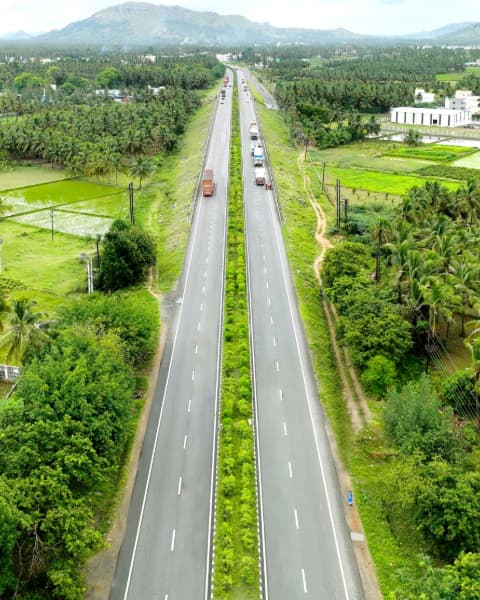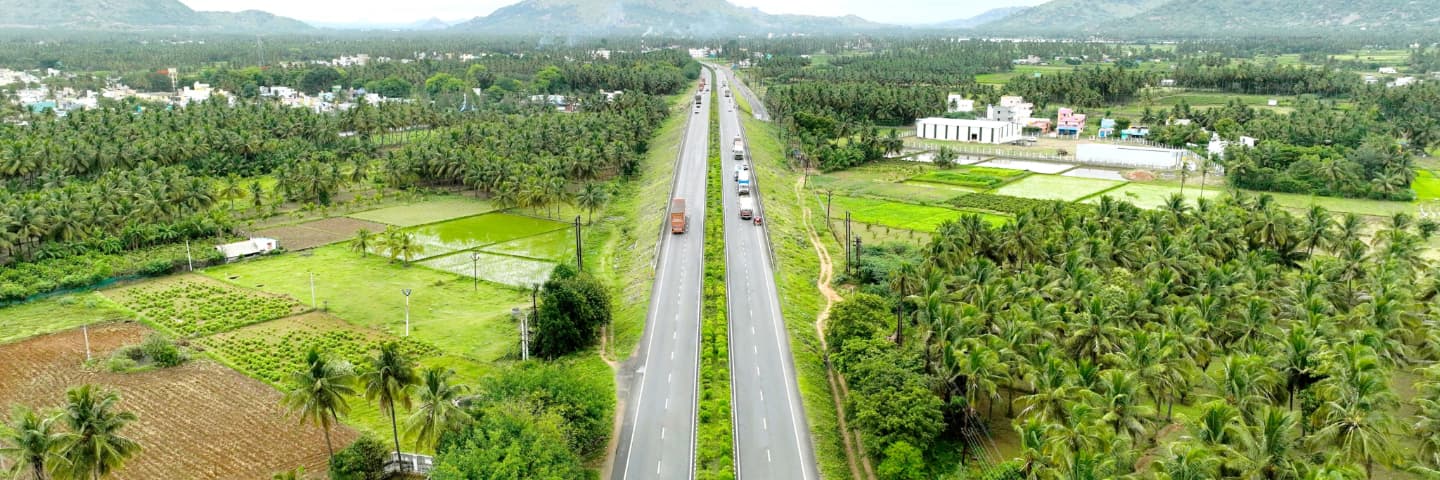Number of Lanes
4
Distance
86 Km
Original Concession Period
20 Years

M/s. National Highways Authority of India has undertaken the widening of the existing 2-lane portion of National Highway No. 44 (NH-44) in the State of Tamil Nadu from Km 94.0 (end of Krishnagiri flyover) to Km 156 (Thurnpipadi), covering 62.5 Kms, to 4 lanes. This project also includes the improvement, operation, and maintenance of Km 156 (Thumpipadi) to Km 163.4 (Thopur ghat) on NH-44 through a concession on a Build, Operate and Transfer (BOT) basis, and an additional highway from Km 163.400 to 180.00. Construction for this project began in July 2006, and commercial operations started in February 2009, with a concession period of 20 years.
National Highway NH-44 (formerly known as NH-7) is a vital artery of the state, connecting the capital of the neighbouring state, Bangalore, to major industrial belts of Tamil Nadu like Coimbatore, Hosur, Erode, and prime tourist locations such as Madurai, Kodaikanal, Ooty, and the state of Kerala. The project highway provides connectivity to ports in Kochi, Chennai, and Tuticorin. The project corridor spans Krishnagiri, Dharmapuri, and Salem Districts, catering to 37% of commercial and 63% of passenger traffic.
The primary corridor from Krishnagiri to Thumpipadi traverses three districts, namely Krishnagiri, Dharmapuri, and Salem in Tamil Nadu. The project's zero chainage point is Km 94.000 and passes through Kaveripattinam (Km 106.00), Karimangalam (Km 115.750), Dharmapuri Town (133.200), and ends at 180.000 at Pannapatti. Much of the proposed alignment runs through rural areas, with land use on both sides primarily falling under agriculture.
The villages and towns along the project highway have prospered economically due to activities such as flower plantations and other commercial ventures. Additionally, the highway serves as a major arterial route, connecting significant tourist destinations like the Vellore Golden Temple, Hogenekkal Waterfalls, Yercaud, and Ooty, further enhancing its importance.
Benefits of the Project Road
Enhanced Connectivity: This project has had a substantial impact on toll revenue by handling 37% commercial and 63% passenger traffic. National Highway 44 (NH 44) is a major North–South National Highway in India, and it is the longest in the country, stretching from Jammu and Kashmir to Tamil Nadu. It provides connectivity to vital locations like Bangalore, Hosur, and key districts in Tamil Nadu and Kerala.
Improved Safety: The project has made significant strides in enhancing safety by incorporating measures such as improved signage, better lighting, and wider lanes. These measures have resulted in a notable reduction in accidents and fatalities on the road. Moreover, special initiatives have been taken in the Thopur Ghat section of the project, leading to a commendable 48% reduction in the accident rate.
Reduced Travel Times: The modernization of the project road has led to a significant reduction in travel times for both commuters and long-haul transportation. This improvement has enhanced efficiency and decreased fuel consumption, making travel more convenient for road users.
Economic Growth: The upgraded road infrastructure has made the region more accessible to businesses, leading to job creation and increased economic opportunities for local communities. This multifaceted development has had a positive impact on the overall economic landscape.
Impact on Road Users
Commuters: Commuters in the region have witnessed a remarkable improvement in their daily travel experiences. With shorter travel times and enhanced safety measures, they can now reach their destinations more efficiently while enjoying an improved quality of life. The road project has not only brought economic benefits but has also contributed to the well-being of the local community.
Truck Drivers: Long-haul truck drivers have experienced a significant boost in their operations, thanks to the reduced transit times and lower operating costs facilitated by the upgraded road infrastructure. The efficiency of the logistics industry has been greatly enhanced, which benefits both the drivers and the businesses they serve.
Tourists: The region's improved road conditions have made it increasingly attractive to tourists. This surge in tourism has had a positive impact on local businesses in the hospitality sector. Tourists are drawn to the region's natural beauty, historical sites, and cultural attractions, all of which have become more accessible due to the road project. This influx of tourists contributes to the economic development of the area while enriching the local tourism industry.
Impact on Communities
Economic Development: The local communities in the region have experienced significant economic growth as a result of the road project. This growth is evident in increased economic activity, the establishment of new businesses, and the expansion of manufacturing and tourism-related enterprises. The project has facilitated the transportation of various commodities, including automobiles, steel, cement, minerals, courier parcels, and agricultural products like food grains, pulses, flowers, fruits, and vegetables. These economic activities have contributed to the region's prosperity.
Employment Opportunities: The road project has become a source of employment opportunities for the residents. These opportunities encompass various roles, including those in construction, maintenance, and tasks related to the development and upkeep of the project, such as toll operations. The creation of jobs has been beneficial for the community, providing individuals with opportunities for economic betterment and stability.
Infrastructure Development: The project has triggered the growth of complementary infrastructure in the region. This includes the development of hotels, restaurants, and service stations, which have not only improved the convenience of travel but have also benefited local entrepreneurs. The expansion of these services is a testament to the economic vibrancy that the road project has brought to the area.
Environmental Impact: The road project has demonstrated a commitment to environmental sustainability. Various measures have been put in place to preserve the ecology and promote sustainable development. Notably, over 21,000 trees have been planted alongside the road corridor, and an impressive 71,000 median ornamental plants have been added. These efforts reflect the project's dedication to maintaining a green and environmentally responsible infrastructure.
Accolades
The project has been certified under six ISO certification categories:
- ISO 9001:2015 Quality Management System
- ISO 14001:2015 Environmental Management System
- ISO 39001:2012 Road Traffic Safety Management System
- ISO 45001:2018 Occupational Health and Safety Management System
- ISO 31000:2018 Risk Management
- ISO 27001:2022 Information Security and Management System
Other Rewards and recognitions include:
- Recognized as one of the top 20 national highway projects in India
- Our project has been awarded by the MoRTH & National Highways Authority of India for Excellency in Toll Operations during the National Highway Excellence Awards in 2020-21
Krishnagiri Thopur Toll Road Private Limited (KTTRPL)
CIN: U45203TN2005PTC057930

